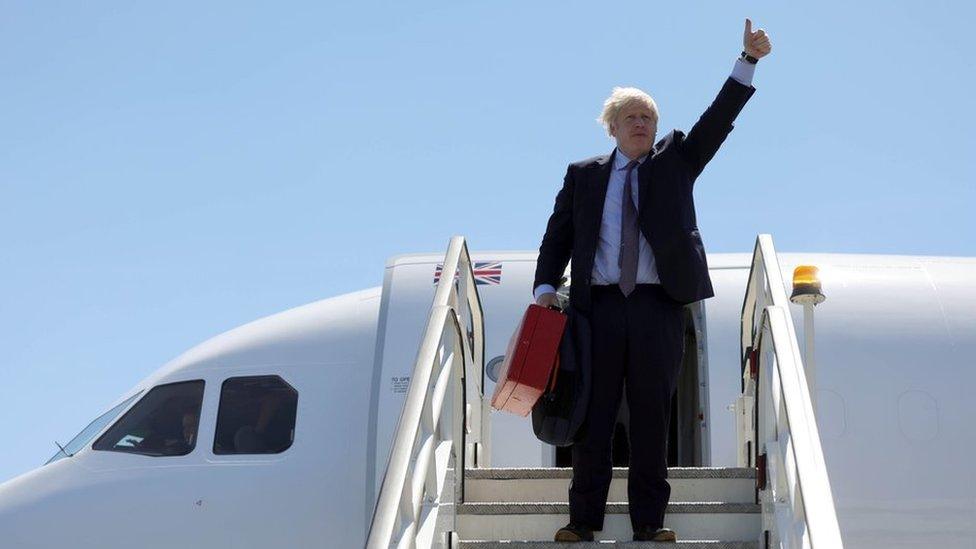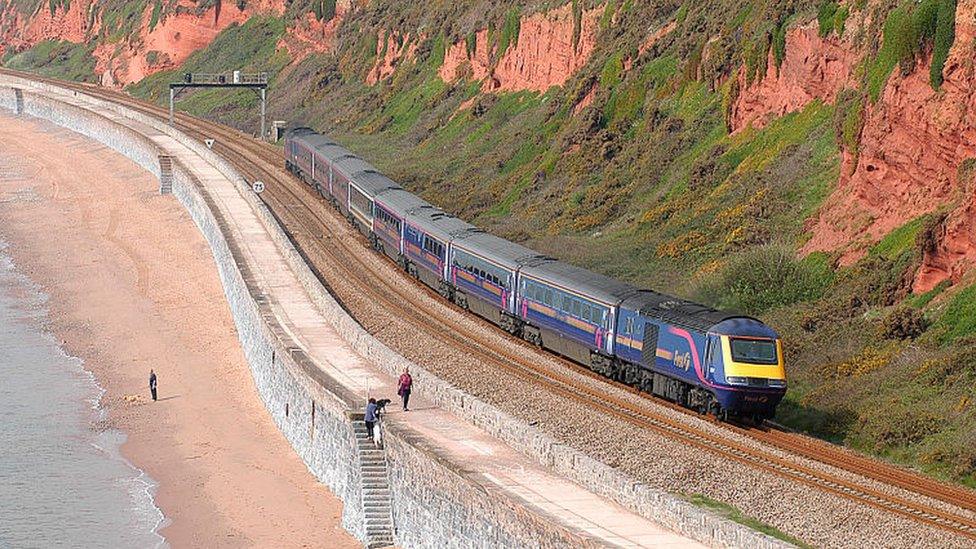G7 summit: How much carbon did Boris Johnson's flight generate?
- Published

Mr Johnson arrived in Cornwall on a flight from London
Prime Minister Boris Johnson flew to Cornwall ahead of the G7 summit - but some have questioned whether it was the most environmentally friendly way of travelling there.
We've looked at the different ways he could have made this journey and estimated the contribution each would have made to carbon emissions.
What is the carbon cost of the flight?
Mr Johnson flew in a chartered Airbus A321 from London Stansted to Newquay, on Wednesday afternoon - a 49-minute journey, according to the tracking site Flightradar24.
We asked his office how many passengers were on board but haven't received a reply.
But we can make a start on an emissions calculation by first considering the carbon dioxide (CO2) contribution per passenger on an average domestic commercial flight.
Using a methodology set out by the government, external for commercial flights, each passenger travelling this distance - 248 miles (399km) - contributes about 97kg (15st 3lb) of carbon dioxide (CO2) to the Earth's atmosphere.

If we assume Mr Johnson's flight had fewer passengers than an average commercial flight, his individual contribution by flying to Cornwall would have been considerably more than this.
It's also a 55-minute drive from the airport to Carbis Bay, where the summit is being held.
And if the prime minister travelled alone (plus his driver) in a luxury car - a Jaguar, for example - using petrol, this would add a further 20kg of CO2.
This accounts for the whole vehicle, unlike the figures for air and rail travel, which produce a per-passenger amount.
A diesel car would contribute considerably less carbon (but higher levels of another pollutant, nitrogen dioxide).

The journey by train between London and Cornwall takes about five hours
What about other modes of transport?
The same journey by train - from London Paddington to nearby St Erth station - releases 14kg of CO2 per passenger, according to the government's carbon-conversion database.
St Erth is five miles from the G7 summit hotel. (The connecting line to Carbis Bay has been suspended for the summit.)
And Great Western Railways offers free wi-fi, so - signal permitting - the prime minister could have completed some work during the journey.
The nearly 300-mile journey from Downing Street by car would have taken a bit longer - about five and a half hours (on a smooth run without any significant traffic hold-ups).
And, assuming the same luxury petrol-using vehicle, the journey would have released about 150kg of CO2, based on the government's database.
Emissions are substantially less from an electric vehicle.
Even for a keen cyclist, the 28-hour bike ride might have been a step too far.
The manufacturing of all these vehicles has a carbon footprint too but we haven't included that here.
BBC Reality Check explains how to cut your carbon footprint
What did Downing Street say?
A No 10 official said: "Ministers are required to make essential visits across the country for official government business.
"The security authorities allow for a wide variety of transport in order for this to be done safely and efficiently."
On his arrival, Mr Johnson defended the flight and pointed to his plan to reach "jet zero as well as net zero".
Net-zero-emission aviation, part of the prime minister's 10-step climate project, envisages zero-emission aircraft using sustainable fuels.
But this is decades away, BBC environment analyst Roger Harrabin says.
And, in October, Cait Hewitt, from the Aviation Environment Federation, told BBC News: "No zero-carbon technology options are currently available for commercial aviation.
"Planes use masses of energy.
"Batteries aren't powerful enough, except for tiny planes.
"And we can only produce biofuels sustainably in small quantities."
